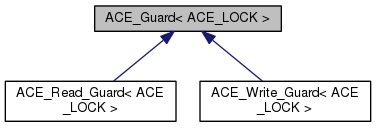This data structure is meant to be used within a method or function... It performs automatic acquisition and release of a parameterized synchronization object ACE_LOCK.
More...
|
| | ACE_Guard (ACE_LOCK &l) |
| |
| | ACE_Guard (ACE_LOCK &l, bool block) |
| |
| | ACE_Guard (ACE_LOCK &l, bool block, int become_owner) |
| |
| | ~ACE_Guard (void) |
| | Implicitly release the lock.
|
| |
| int | acquire (void) |
| | Explicitly acquire the lock.
|
| |
| int | tryacquire (void) |
| | Conditionally acquire the lock (i.e., won't block).
|
| |
| int | release (void) |
| | Explicitly release the lock, but only if it is held!
|
| |
| void | disown (void) |
| |
| bool | locked (void) const |
| |
| int | remove (void) |
| | Explicitly remove the lock.
|
| |
| void | dump (void) const |
| | Dump the state of an object.
|
| |
template<class ACE_LOCK>
class ACE_Guard< ACE_LOCK >
This data structure is meant to be used within a method or function... It performs automatic acquisition and release of a parameterized synchronization object ACE_LOCK.
The ACE_LOCK class given as an actual parameter must provide, at the very least the acquire(), tryacquire(), release(), and remove() methods.
- Warning
- A successfully constructed ACE_Guard does NOT mean that the lock was acquired! It is the caller's responsibility, after constructing an ACE_Guard, to check whether the lock was successfully acquired. Code like this is dangerous: { ACE_Guard<ACE_Lock> g(lock); ... perform critical operation requiring lock to be held ... } Instead, one must do something like this: { ACE_Guard<ACE_Lock> g(lock); if (! g.locked()) { ... handle error ... } else { ... perform critical operation requiring lock to be held ... } } The ACE_GUARD_RETURN() and ACE_GUARD_REACTION() macros are designed to to help with this.

 1.8.2
1.8.2